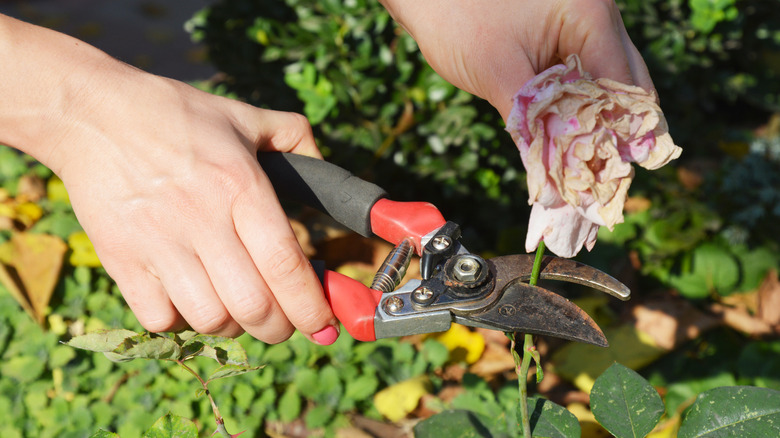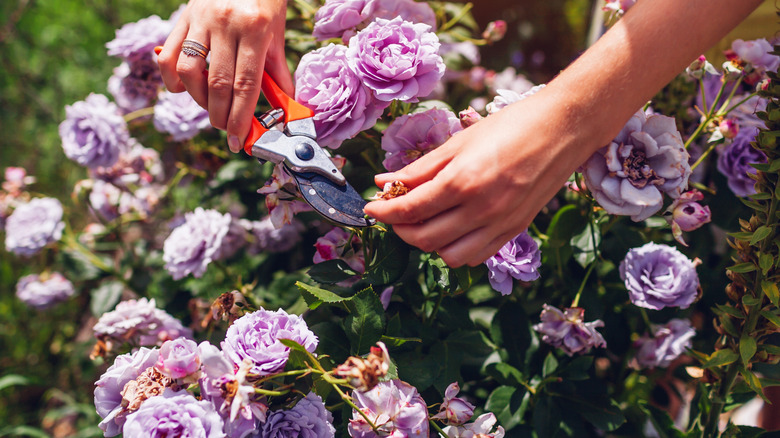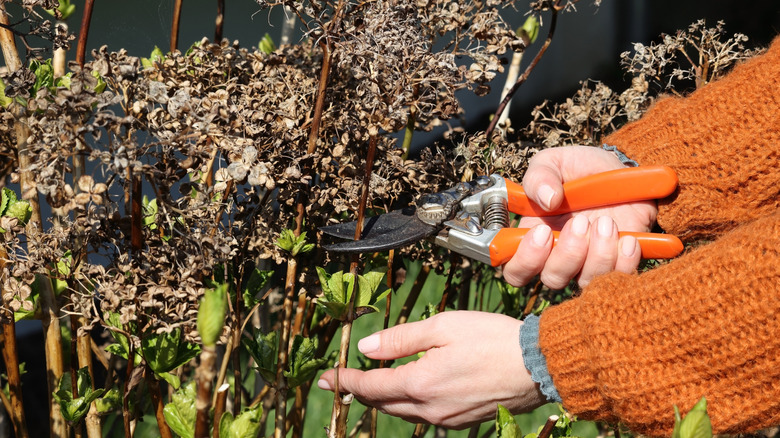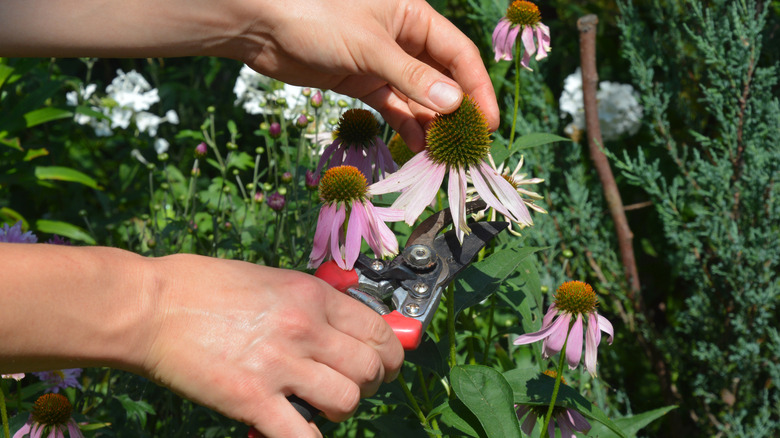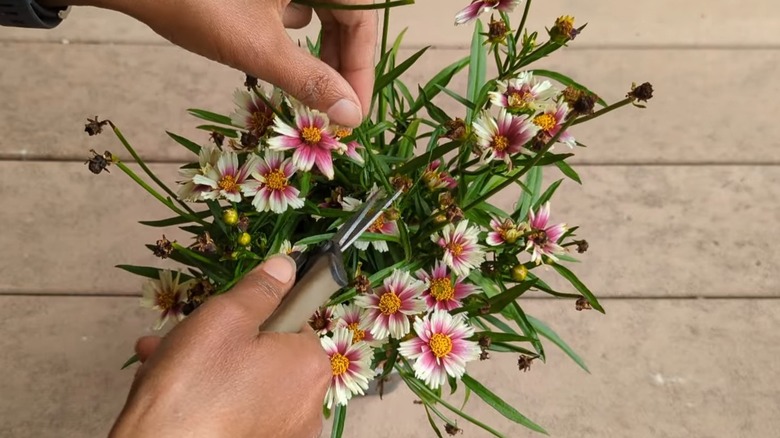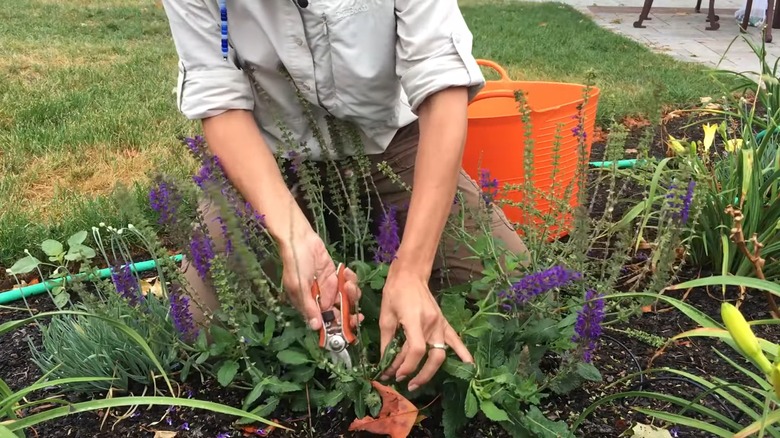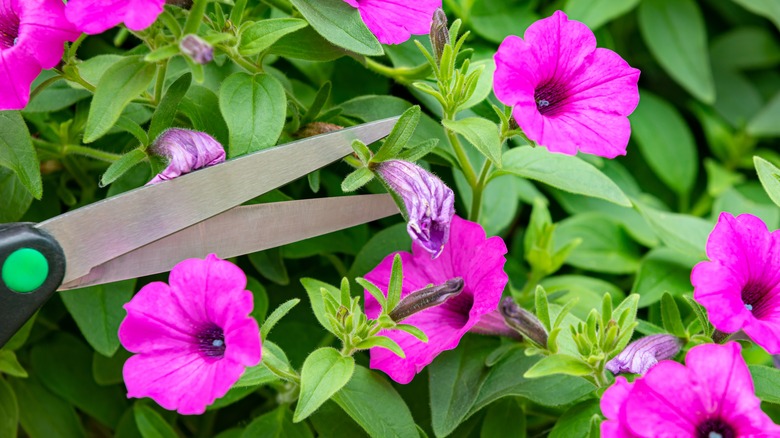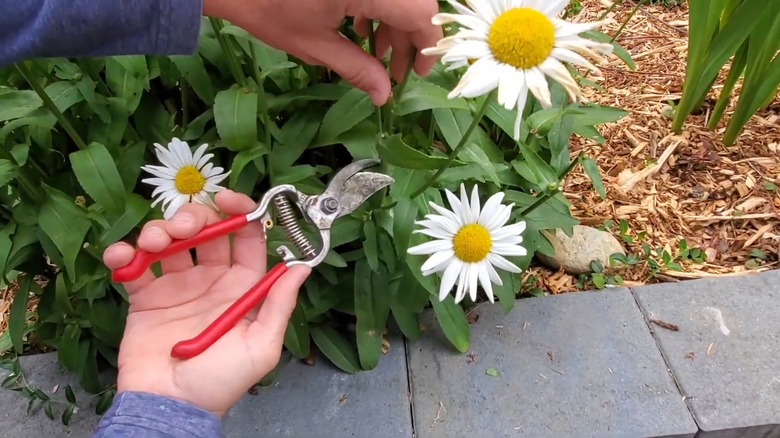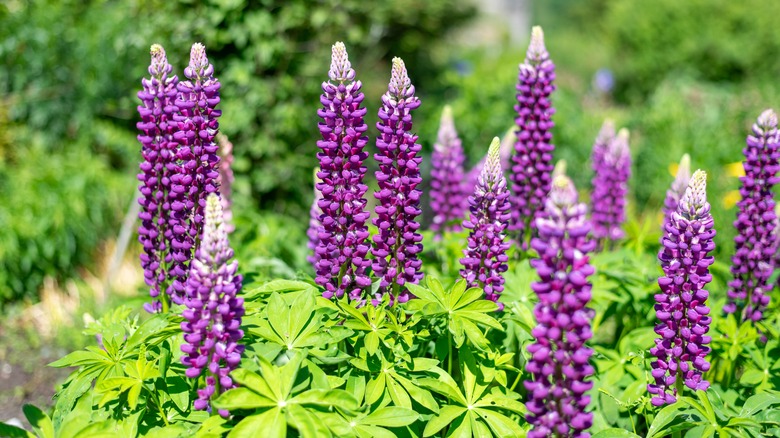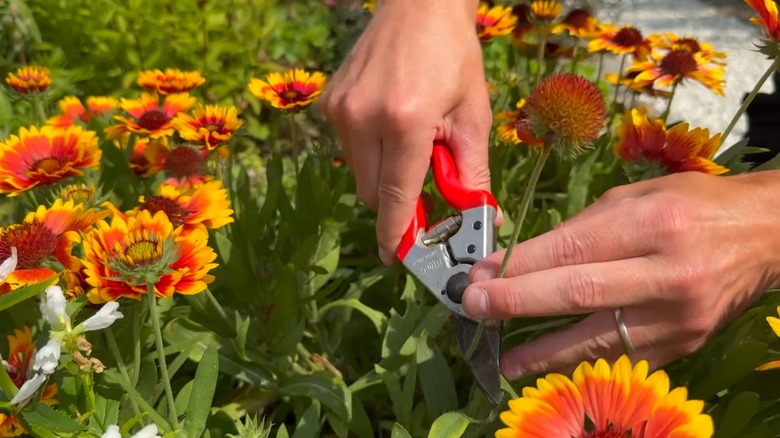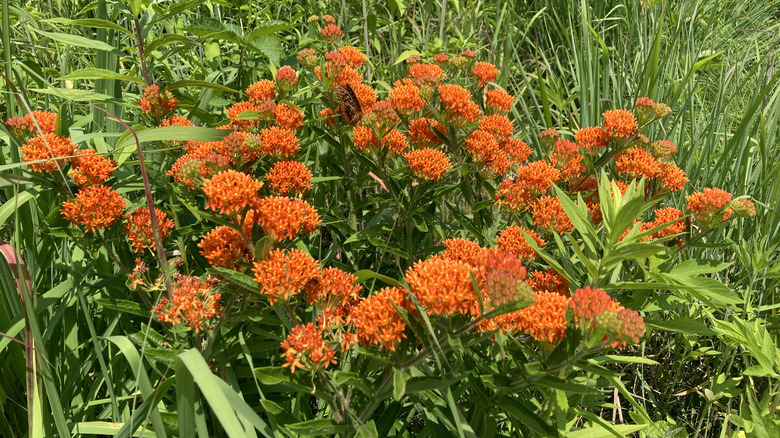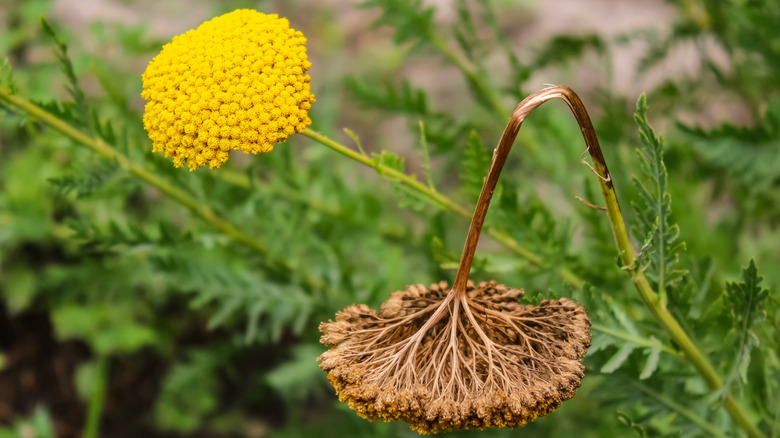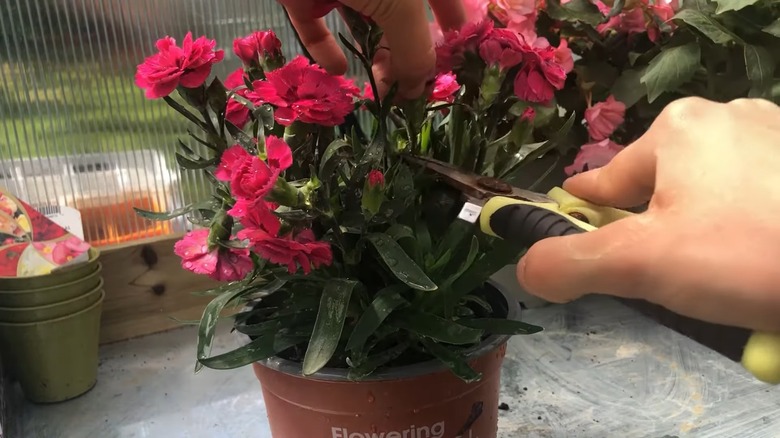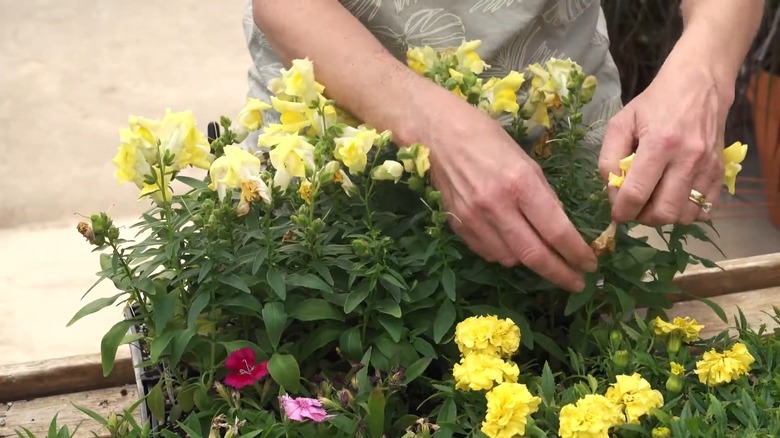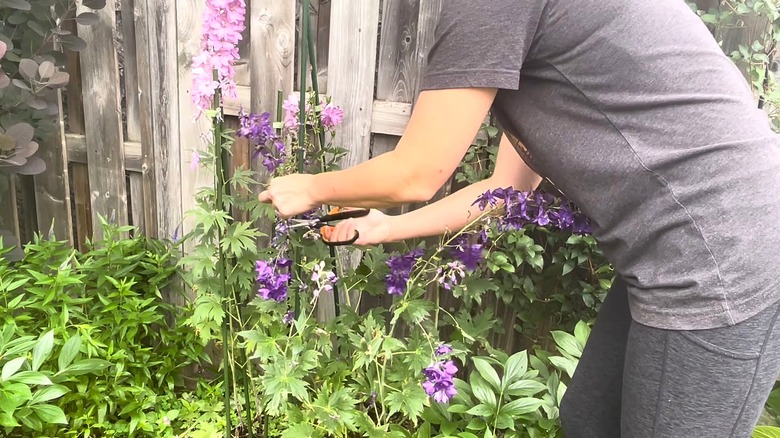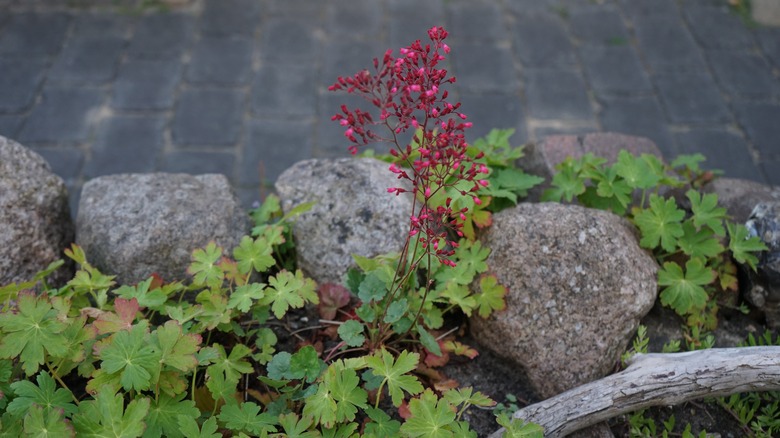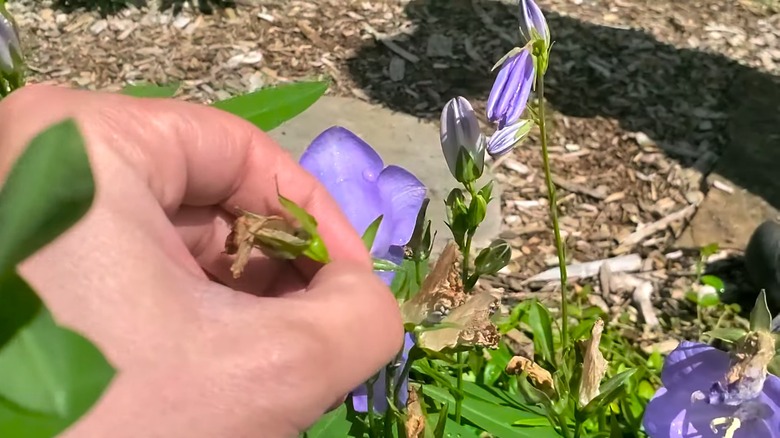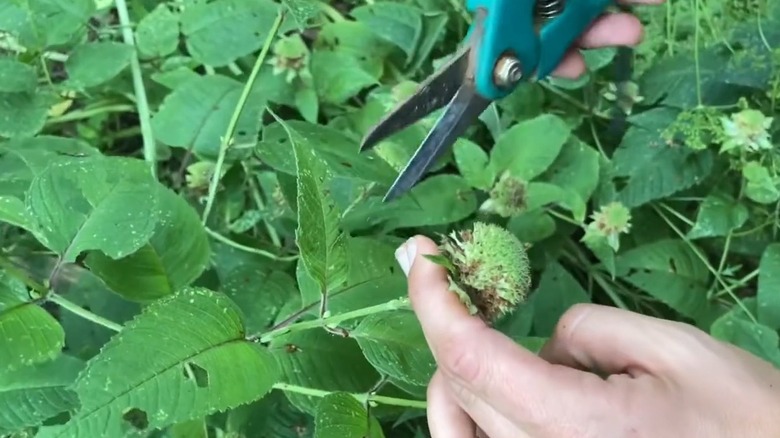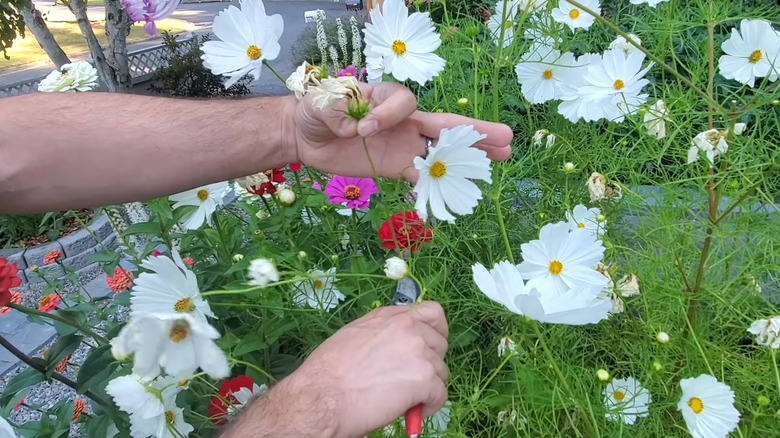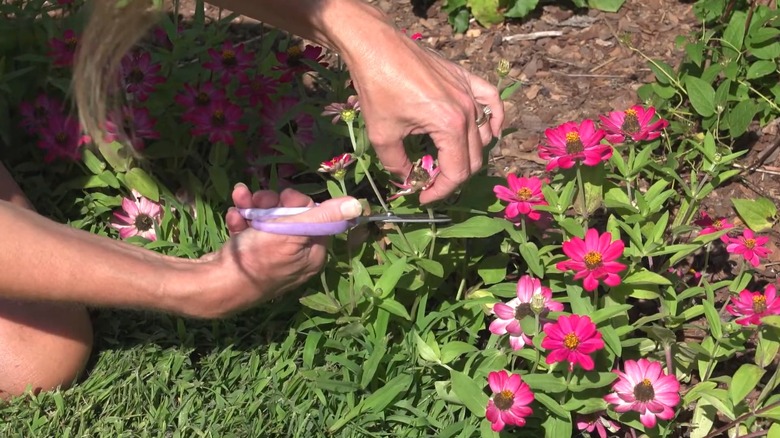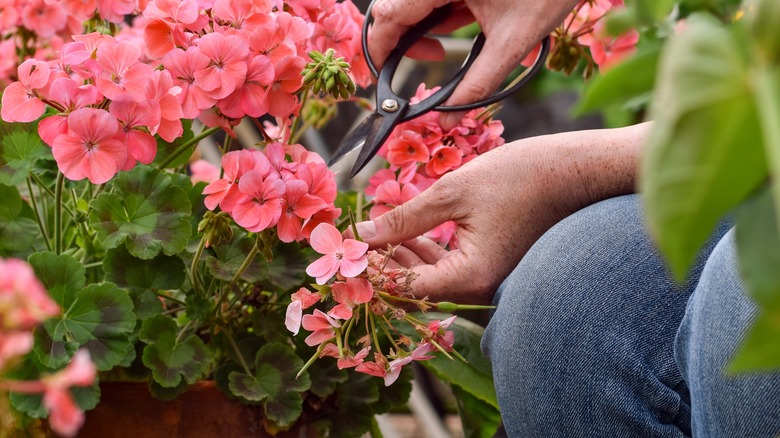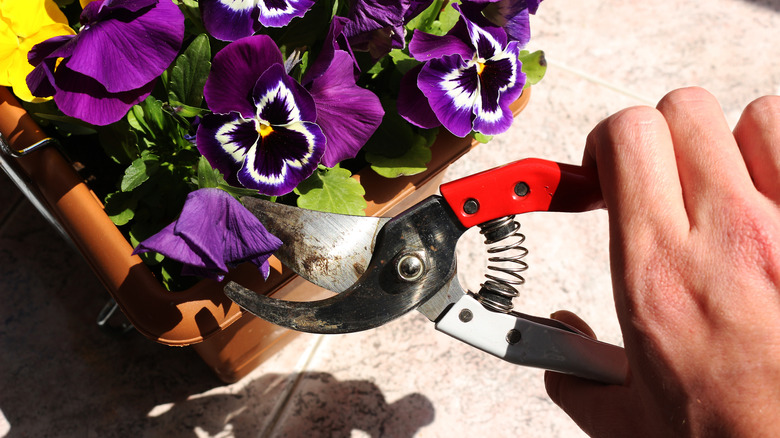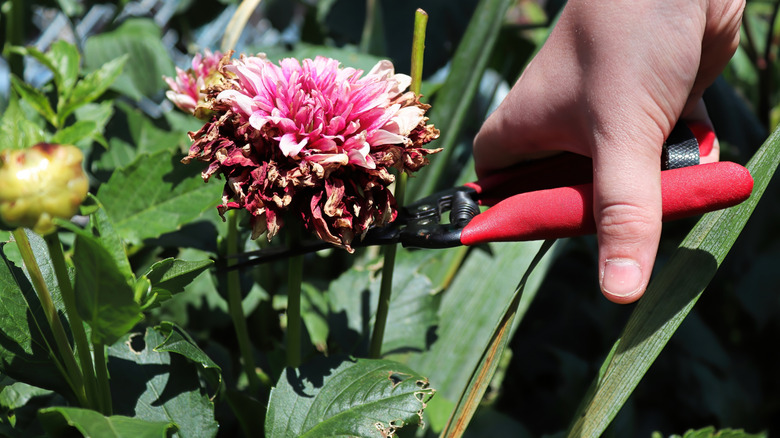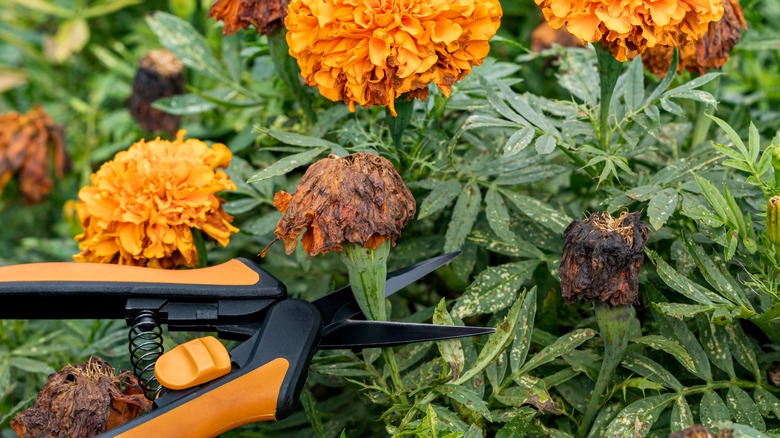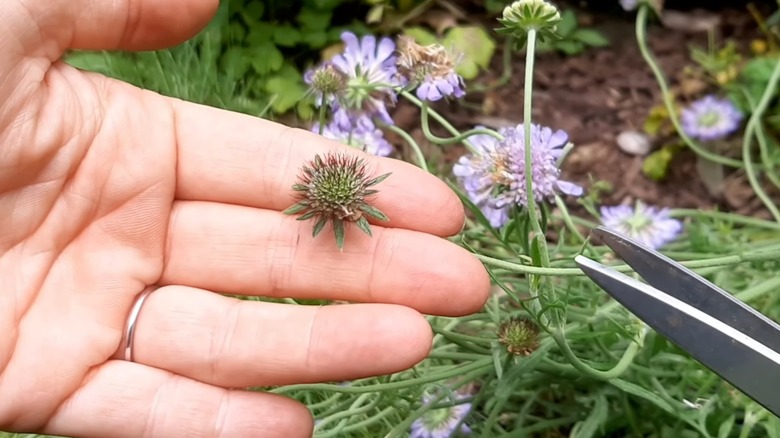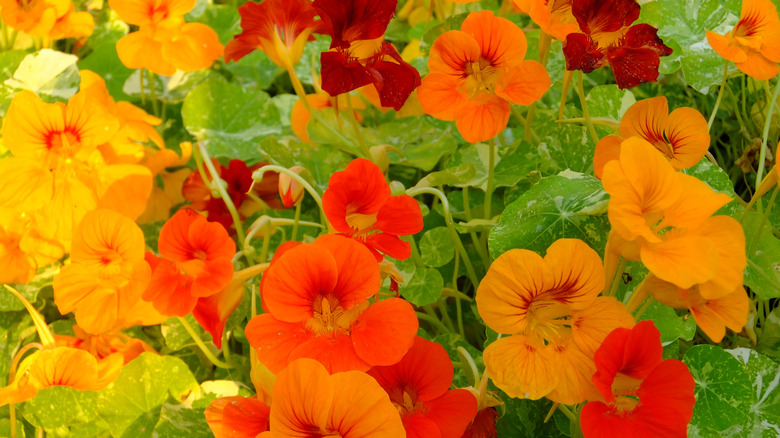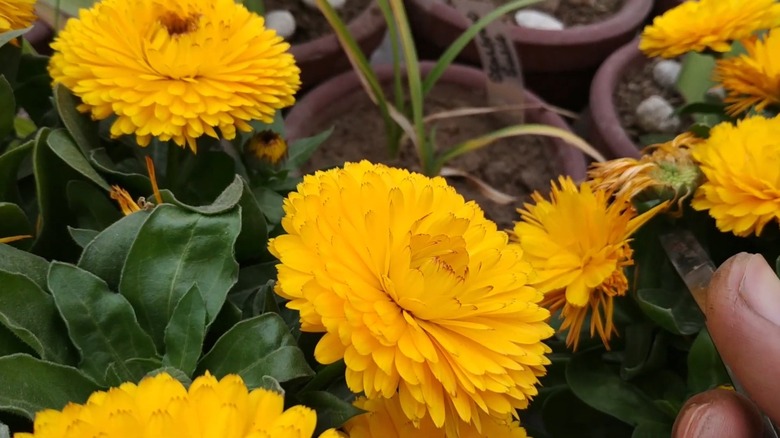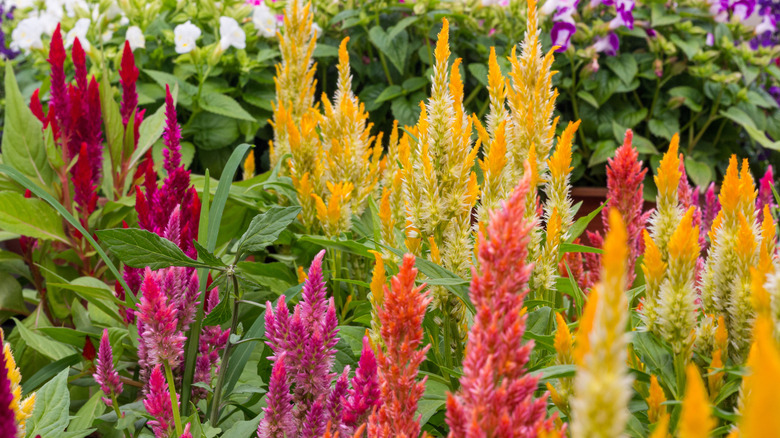27 Flowering Plants You Should Always Deadhead For Maximum Blooms
We may receive a commission on purchases made from links.
It can be disappointing when, after making you wait for months on end, the flowering plants in your garden exhaust their blooms in a few weeks. Fortunately, you can encourage some of them to remain in bloom or rebloom for much longer through deadheading — the practice of removing spent flowers from the plant. Roses, tickseed, salvia, petunia, blanket flower, dianthus, bee balm, and delphinium are some leading examples, though there are more, as you'll discover below.
The reason deadheading works in maximizing blooms is that it forces the plants to resume flower production because they were denied the chance to produce seeds in the initial flowering cycle. Hence, to ensure their legacy is carried forward, these flowering plants (especially annuals) push out new blooms. That being said, note that not all succeeding blooms will be as flowerful and lush as the first round. Also, deadheading doesn't induce more blooms in every plant; it usually only works on repeat bloomers or plants with a long flowering season. Before starting, ensure you have a sharp pair of garden clippers, like Fiskars Bypass Pruning Shears, on hand. Not all plant stalks can be snapped with fingers, and some may cause skin irritation upon contact. Disinfect the clippers with 70% rubbing alcohol concentration. When you're ready, follow through to learn about the plants you should be deadheading — and do so when you spot any of them in your garden.
Roses
Not deadheading is one of the leading gardening mistakes to avoid to get more blooms from your roses (Rosa spp.), especially hybrid teas, floribundas, and grandifloras (repeat-bloomers). Faded blooms cue the shrub into growing seeds or rose hips, putting a full stop to new flushes. As you'll have noticed, the spent stalk has three- and five-leaflet leaves as you move top-down. For newly planted roses, cut the stalk just above the highest three-leaflet leaf to avoid compromising their growth. For established specimens, snip above five-leaflet leaves. For flower clusters with dead blooms, pinch them to help the rest bloom.
Reblooming hydrangeas
If you've planted reblooming or remontant hydrangeas — think series like Let's Dance, White Wedding, Endless Summer, Bloomin' Easy, and Seaside Serenade — you should deadhead the faded blooms right after they finish their first cycle. That way, you can expect another flower flush late into the growth season. To deadhead, simply cut down the spent stalk to the newest bud or the biggest pair of leaves if you can't spot the buds yet. Avoid removing the dead blooms after the repeat cycle, as they add winter interest with their aging colors and double as winter habitat for beneficial insects.
Purple coneflower
Before you exclaim, "But goldfinches want those seeds!" know that to extend purple coneflower's (Echinacea purpurea) flowering season right up to frost, you must deadhead them. This will also keep the plant tidy while keeping your summer gardens bright. More than that, it prevents the coneflowers from taking over your garden completely — unless that's the aim — as they produce countless seeds. If you would still like to make your own birdseed by retaining dead blooms, consider allowing a small patch to go to seed while the rest is deadheaded. Or, stop deadheading completely when fall approaches.
Tickseed
Tickseed (Coreopsis spp.) is a low-maintenance perennial that will thrive in your poor and rocky soil. To enjoy its gorgeous blooms for a long time, remove the dead flowers as you spot them throughout the summer. This will redirect resources from seed production to repeat blooms, improving their appearance. Using a sharp pair of shears, cut the dead stalk down to the nearest pair of healthy leaves or the joint where it connects to a healthy branch. Since tickseed is short-lived, stop deadheading in the fall to ensure seed production for a reliable return of blooms.
Salvia
When your salvias start looking rangy, deadhead them. Any flower stalk that's at least 70% brown and ready to seed can be snipped off down to the foliage or the nearest side branch. This should encourage the plant to produce new buds — sometimes within two weeks, even through a raging drought. Also, it enhances the plant's overall appearance. However, if you have a large salvia variety, you can wait for the first bloom cycle to end and cut back a third of the foliage to encourage reblooming later into the season.
Petunia
Have you ever wondered how to get your petunias to rebloom and last all season long in the summer heat? Deadhead them. Pinch flowers when they grow withered mid-summer and chop their long stems, too — after all, headless stems don't make for a pretty plant. This will push petunias (Petunia x hybrida) to produce more blooms, enabling them to develop seeds later for a new opportunity at life come next year. Understandably, if you've laid down a colorful carpet of petunias, trimming them all might not be feasible. But make sure to do so for container plantings.
Shasta daisy
So, you've planted the best varieties of Shasta daisies to enjoy colorful blooms all summer long, along with the pollinators they attract. Extend their flowering period way into fall by timely deadheading the blooms once they're past their prime. Scientifically named Leucanthemum x superbum, Shasta daisies are easy to trim down. Simply locate the next buds on the spent flower stalk and clip right above them. You'll find new flowers in about three weeks. But if you don't find any budding growth, shave off the stem's top to about ½ inch above soil level to promote more branching.
Lupine
When the towering flowers atop your lupine plants go from looking gorgeous to unattractive, disappointing the visiting hummingbirds, it's your cue to deadhead the dying blooms. With a pair of clean clippers, cut the spent spike right above the healthiest pair of leaves. This will stimulate the plant to grow new flowering spikes, regaling you with a repeat flush later into the summer. In addition, trimming out old growth will tidy up its appearance, ensuring plant beds and borders remain aesthetically pleasing. Leave the growth after the second cycle so the plant may self-seed in the area.
Blanket flower
You may have planted blanket flowers (Gaillardia spp.) in your attempt to deter deer or establish a water-wise landscape. However, to continue enjoying these benefits, consider deadheading the wilted blooms whenever possible. Be sure to wear gloves, as blanket flowers can irritate the skin. As deadheading redirects energy from seed production, these short-lived plants can extend their life until you're ready to divide them in a couple of years. Better still, the perennial continues to add new buds, making sure you enjoy a long blooming season. Retain a few last blooms so the birds may enjoy the seeds.
Butterfly weed
To support monarch caterpillars and enjoy the bevy of bees, moths, and hummingbirds that come for their tangerine blooms, you may have planted butterfly weed (Asclepias tuberosa) in your garden. However, you can further benefit these pollinators and enjoy a longer blooming period by deadheading them. As the first flush of blooms wilts, lop off their heads down to the nearest pair of leaves. These dried heads can be used in flower arrangements if desired. Expect new blooms after a month. Allow the final flowers to produce seeds for self-sowing and share some with thy neighbor.
Fernleaf yarrow
To maximize blooms on fernleaf yarrow (Achillea filipendulina), it's ideal to deadhead them when they start to cut a sorry figure. Remove the stems supporting the browning flowers down to the basal foliage (leaves near the plant's base). The new blooms will attract more pollinators and beneficial insects, and maybe even a few insectivorous birds who have a taste for them. Deadheading regularly will also keep fernleaf yarrow's self-seeding and weedy tendencies in check. This is important because, despite not being considered invasive, these perennials have a history of naturalizing in parts of the American continent.
Dianthus
Dianthus or pinks can be encouraged to rebloom continually if you deadhead them. Plus, the plant will look sharp. When you spot a wilting bloom, snip off its stalk where it protrudes from the rounded, leafy mound (it should be a couple of inches above ground). Or, right above lateral buds if you spot any. In case you're strapped for time, wait for all the flowers to die down, trim the stalks to the basal mound, and watch them bloom again in the fall. Start at the edges so you can easily locate the top of the leafy mass.
Snapdragon
Snapdragons (Antirrhinum majus) benefit from being deadheaded because it helps prolong their flowering season, apart from cleaning up their appearance. Where time allows, keep pinching off the flowers as their petals turn brown and droopy. Take off the lower section, too, to prevent pod production. Alternatively, snip off the whole stem when all its flowers fade away from the point it connects to the side branches. That way, you can still enjoy the lateral flowers. In case of poor flower quality, cut back a third of the foliage mid-summer to encourage another flowering cycle.
Delphinium
Another flowering plant you should consider deadheading for additional bursts of blooms is delphinium. Once the petals fade out, nip the dead blooms to restore the plant's visual appeal. When the whole flower spike is spent, clip it off at the point closest to the next lateral bud or branch — keep checking back every 10 days or so. Otherwise, wait for all the spikes to exhaust themselves and shear them off so the new flowers appear by the end of summer or early fall. Remember, they won't be as lush or large as the first flush.
Coral bells
In case the coral bell (Heuchera sanguinea) variety gracing your yard produces flowers, you'll do well to deadhead it after the flowers fade. This will increase floral production, coaxing more spurts through the summer and autumn, though they won't be as full as the initial cycle. As bees and butterflies find these blooms attractive, you can prolong their stay as well. When you chance upon a dead flower stalk, clip it back to ground level, making sure the surrounding leaves remain intact.
Bellflower
When deadheaded timely, you can coax bellflowers (Campanula spp.) into producing additional blooms later in the growing season. This will also put a lid on their self-seeding tendencies, ensuring they don't overcrowd the bed. This is particularly important if the planted variety is the creeping bellflower (Campanula rapunculoides), which is invasive in some U.S. states. Regarding deadheading, snap off the flower stalk after the blooms wither to the nearest leafy or bud growth — try to check back weekly. Or, trim the dead stalks back to ground level until you spot green growth.
Bee balm
Make your backyard's pollinators happier by deadheading bee balm (Monarda spp.). Once you remove the mass of faded flowers, it encourages the plant to rebloom later in the season and minimizes disease pressure by opening up the airflow. It also prevents bee balm from taking over your garden, as you haven't allowed it to go to seed yet. Trace down the spent stalk until you discover a new bud, and cut ¼ inch above. For stems without new buds, cut them back to the ground, though they may not flower again in the current season.
Cosmos
To encourage cosmos to keep bursting new blooms up to frost, keep removing the dying flowers. This will also limit the time you spend picking off volunteer seedlings — after all, cosmos seed prolifically. Shave off the fading stem above the nearest side shoot so they may begin blooming. The diverted resources will speed up blooming on them and stimulate new shoot growth. But if you've planted them in drifts, wait for the whole plant to grow drab, then shear off the foliage to about 12 to 18 inches above ground, around mid-summer. New blooms will appear in four weeks.
Zinnia
If you haven't been cutting zinnias (Zinnia elegans) for indoor arrangements, choosing to enjoy them in your garden instead, try deadheading them. Busybodies can snap off the dead blooms as they go about their day, while perfectionists could take floral scissors to the wilting bloom and follow its stem down to the nearest leaves. At the cut, new shoots will pop out, extending the flowering season. Nearing fall, allow the last batch to make seeds for birds and self-sowing. You don't have to deadhead newer varieties like the Preciosa or Profusion series, as their new flowers cover old ones.
Geranium
Most annual geranium (Pelargonium spp.) varieties, including zonal and hardy geraniums, benefit when their dead blooms are consistently removed. This releases the resources planned for seed setting, directing them to create more blooms. The best method for deadheading geraniums is to locate the fading flower, rotate its stalk sideways, and break it off at the lumpy green growth or leaf node. New flowers will push out from these nodes while you're still enjoying the current blooms, prolonging the display. This will also enhance the plant's appearance. That said, deadheading isn't necessary if you're growing seed and wild geraniums.
Pansy
When you don't deadhead pansies (Viola × wittrockiana), they expend a lot of energy producing seeds, which reduces the mass of the current blooms. For this reason, during their flowering season — at least every couple of weeks — you must keep an eye out for any floppy or faded blooms. Once spotted, snip their stalk off where it joins the main stem. This will stimulate the growth of lateral shoots, making the plant bushy. Plus, it'll lengthen the flowering season through new flowers. Plus, your pansies will look clean and perky after such a trim.
Dahlia
Once the petals on dahlias decline, turning brown or drooping, cut them off to promote reblooming. The best method for deadheading dahlias is to trace the spent flower stalk until you spot a new bud or a side branch and then snap it right above either of these points. Cutting back the foliage to the healthiest set of leaves will increase plant size. When deadheading, don't wait for the petals to drop on their own, as such spent buds appear similar to new ones, though they're usually pointed and squishy to touch. New buds are rounded and tightly balled.
Marigold
Unless you've been planting the newer, compact varieties (think 'Tangerine Gem'), most marigold (Tagetes spp.) varieties should be deadheaded. Besides lowering the probability of a disease outbreak (since open plants allow proper air circulation), this promotes the production of additional blooms. Do so near-daily so you may enjoy marigolds and the pollinators they attract throughout the summer. This will also help maintain a neat habit, especially in humid climates where faded marigolds are quick to rot. Once the flowers start to wilt, pop them all off right above the nearest set of leaves or any budding growth.
Pincushion flower
Unless your pincushion flowers (Scabiosa spp.) are sitting in a cottage or a prairie garden where you don't mind their informal, low-maintenance look, consider deadheading them. This will improve the quality of the flowers and the length of time they remain in bloom. Ideally, start pinching when the flowers are browning, as the petal-less buds can be a tad difficult to distinguish from new buds. Spent buds are hairier and look worn out, while the new ones are more bundled-up and fresh-looking. Slice the flower stalk with your fingers or clippers where it's closest to the main stem.
Nasturtiums
Do you want to keep pollinators enthralled with your yard? Deadhead nasturtiums regularly to encourage additional blooms and attract beneficial insects by the dozens until the plants are frost-killed. Deadheading will curb seed production, preventing the plant from dominating the bed to the utter delight of abutting ornamentals or vegetables. Scan the plant for blooms that look run down — they'll usually be attached to a stem that's curling inward as opposed to standing upright. Snip the stem down to the mass of green leaves (avoid cutting these leaves as they're essential for photosynthesis).
Pot marigold
If you aren't harvesting pot marigold or calendula (Calendula officinalis) flowers for cut arrangements, you may want to keep deadheading them. As these annuals are profuse seeders, lopping off their dead blooms would help them bloom afresh instead of wasting resources on their production. This also prevents the beds from becoming overcrowded. When the flowers dry down, either pinch them off or clip them with a pair of scissors. Expect the plant to remain in continual bloom until frost hits, which should, in turn, pull in more pollinators.
Cockscomb
To enable cockscomb (Celosia spp.) to conserve the energy it puts into setting seeds, deadhead them throughout the growing season. That way, the plant will be forced to produce new flowers, remaining in non-stop bloom until frost (seed savers can quit deadheading in the fall). Once the flower starts displaying signs of wilting, snip off its stalk at the point it's connected to the main stem or the next bud. You don't want to wait too long for this, or it may grow seedpods underneath the faded flower. You can add the dried flowers to floral arrangements.
